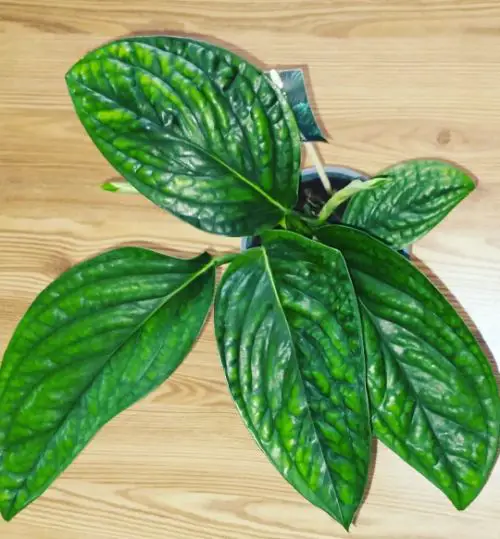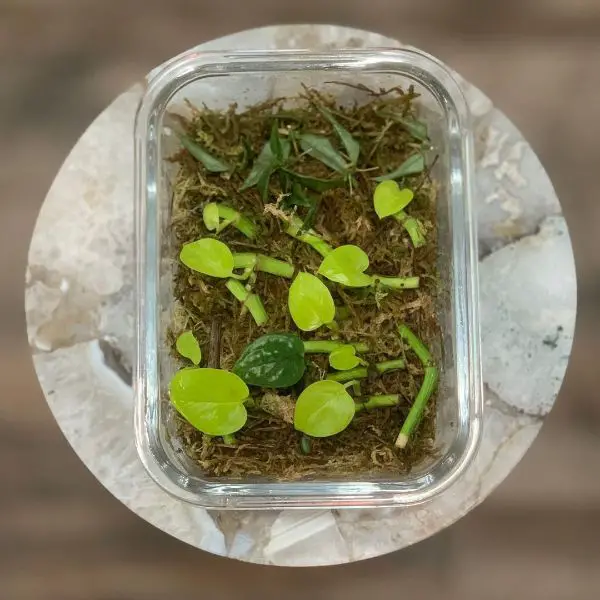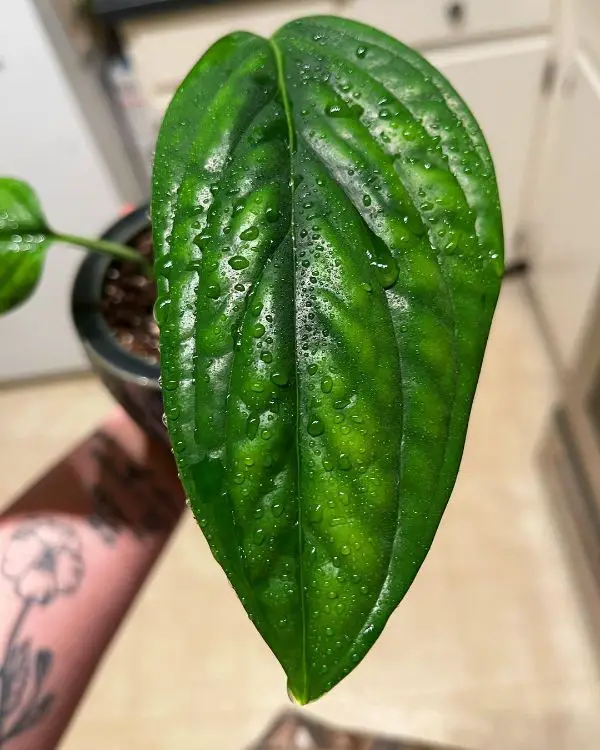Monstera plants are beautiful, exotic houseplants that are gaining in popularity. They are easy to care for, but there are a few things you need to know to keep them healthy and looking their best. This guide will discuss everything you need to know about Monstera Peru care
We will cover basic information such as watering and light requirements, as well as more specific tips like dealing with pests or propagating new plants. So if you have a Monstera Peru plant and want to make sure it stays happy and healthy, read on!
What is the Monstera Peru?
The Monstera Peru, often referred to as the Monstera Karstenianum, is a unique plant that resembles a Monstera but functions more like a succulent. It has brilliant, glossy, green leaves that feel leathery to the touch and doesn’t get very big. Additionally, the leaves have stunning deep green veining.
The veins will appear like an exquisite carving as the plant matures and becomes deeper and darker. This variety’s leaves don’t have any splits or holes like the Monstera Deliciosa and Monstera Adansonii have.
As a hemiepiphyte, the Monstera Peru spends some of its time in nature on its own and spends the rest of its time growing on top of other plants and trees. In addition, this plant looks lovely, is low-maintenance, and almost seems to have been created specifically to be a houseplant.
Monstera Peru is a very rare, quickly growing plant with thick, very stiff leaves that are frequently confused with Monstera Pinnatipartita when young. In contrast to the Monstera Pinnatipartita leaves, which are more elongated, Monstera Sp. Peru leaves are a little wider and appear rounder.
Monstera Peru care
With spoon-like leaves and a tropical flare, the Monstera Peru is a beautiful addition to any home. But before you can enjoy this exotic plant, you’ll need to know how to take care of it!

Monstera Peru Light Requirements
Monstera Karstenianum has evolved to flourish in the dispersed and filtered sunshine that filters through the forest canopy in the Peruvian rainforest.
If your house doesn’t have a forest canopy, that’s too bad. Place the plant a few meters away from a direct light source, behind some shades or a screen, or create your own jungle terrarium (my personal favorite) to recreate the same strong indirect lighting circumstances!
Although the succulent-like leaves of Monstera Peru are more durable than most and can take intermittent direct sunshine, north-facing windowsills will be excellent for most homes.
An East-facing window, where they’ll get some softer early-morning light, should also work.
This Monstera vine can be pretty tolerant, although it doesn’t really thrive in the shade. Typically, a plant’s darker green leaf color indicates that it can survive low light conditions.
How to propagate Monstera Peru
Monstera Peru is a beautiful, fast-growing plant that is easy to propagate. All you need is a healthy stem with at least two leaves.
- First, cut the stem just below a leaf node (the point where the leaf attaches to the stem). Make sure your cutting tool is sharp and sterilized to avoid infection.
- Next, place the cutting in a glass of water and wait for roots to form. This can take anywhere from a few days to a couple of weeks.
- Once roots have formed, you can pot your Monstera Peru in a well-draining potting mix. Be sure to keep it in a warm, humid environment and give it plenty of bright indirect light.
With a little patience and care, your Monstera Peru will soon be thriving!

What level of humidity works best for a Monstera Peru?
Monstera Peru thrive in humid environments, so it is important to maintain a high level of humidity around the plant. The ideal level of humidity for a Monstera Peru is between 60% and 80%.
The level of humidity that works best for a Monstera Peru depends on the time of year and the plant’s stage of growth. In the spring and summer, when the plant is actively growing, it prefers a higher level of humidity. This can be achieved by misting the leaves regularly or by setting the plant on a pebble tray.
However, in the fall and winter, when growth slows down, the plant can tolerate a lower level of humidity. If the air in your home is particularly dry, you may want to consider investing in a humidifier.
How to fertilize a Monstera Peru?
In its natural habitat, Monstera Peru would receive nutrients from decomposing leaves and other organic matter. However, when grown in pots, Monsteras need to be fertilized regularly to ensure that they receive the nutrients they need. The best way to fertilize a Monstera is to use a balanced fertilizer, such as 10-10-10.
Apply the fertilizer once a month during the growing season, and dilute it by half for young plants. Be sure to follow the manufacturer’s instructions, as too much fertilizer can damage the roots and foliage.
You may also like: The best fertilizer for Monstera?
How Often to Water Monstera Peru
The frequency of watering will depend on a number of factors, including the size of the plant, the type of potting mix, and the temperature and humidity levels. In general, Monstera Peru should be watered once a week, allowing the soil to dry out slightly between waterings.

If the plant is kept in a pot with good drainage, you may need to water it more often during hot weather or if the potting mix dries out quickly. Over-watering can be just as harmful as not watering often enough, so it is important to pay attention to your plant and adjust your watering schedule as needed.
Substrate / Soil for Monstera Peru care
Monstera Peru requires well-draining, breathable soil compositions that can truly supply some airflow around the roots, as do any plants that dabble in the epiphytic lifestyle.
However, because of its shallow roots, this vine probably won’t penetrate the ground very deeply, so you’ll also want something that can hold moisture.
With its fibrous, spongy structure and water-retentive properties, coco coir provides an ideal substrate base. For added drainage and aeration, you can supplement with materials such as orchid bark, pumice, or perlite.
Repotting
Repotting Monstera Peru is a vital part of care for the plant. The roots become constricted over time and need more room to grow. Also, the soil begins to degrade and no longer contains the nutrients that the plant needs. Repotting should be done every two to three years, in the springtime.
Use a well-draining potting mix and a pot that is only one or two sizes larger than the current one. Gently remove the plant from its current pot and replant in the new pot, being careful not to damage the roots. Water well after repotting and keep an eye on the plant for the next week or so, as it may go into shock.
You may also like: Best pot for Monstera – Tips to help you choose the right planter
Pruning
Pruning is an important part of Monstera Peru care. By selectively removing leaves, you can encourage the plant to produce new growth. This can help to keep the plant healthy and prevent it from becoming overgrown. Pruning also allows you to control the shape of the plant, so you can create a fuller, more attractive specimen.
When pruning, always use clean, sharp shears to avoid damaging the plant. Make sure to remove any leaves that are yellowing or damaged.
Prune Monstera Peru back to a main stem or lateral branch, taking care not to remove too much foliage at once. Pruning will stimulate new growth, so be prepared to water and fertilize the plant more frequently.
Read More about Pruning Monstera here: https://dignursery.com/how-to-prune-monstera-plant/
Pests and Diseases
Pests and diseases are common problems with Monstera Peru. They can be caused by a number of factors, including poor drainage, over-watering, and lack of nutrients. Pests such as mealybugs and aphids can quickly infest the plant, causing leaves to yellow and drop off.
Diseases such as powdery mildew and root rot can also cause serious damage. The best way to prevent pests and diseases is to provide the plant with proper care. Make sure that the pot has good drainage, water only when the soil is dry, and fertilize regularly. If pests or diseases do occur, try to remove them manually or treat with an insecticide or fungicide.
Common problems when caring Monstera Peru
Common problems when caring for a Monstera Peru can include over- or underwatering, which can lead to leaf browning or yellowing; not enough light, which can cause the plant to become etiolated (stretched and thin); or too much direct sun, which can scorch the leaves. Other problems can include pests like mealybugs, scale, or aphids, or diseases like root rot or powdery mildew.
To avoid these problems, it is important to water your Monstera Peru regularly and evenly, making sure that the soil drains well. Provide bright, indirect light, and protect the plant from direct sun. Inspect the plant regularly for pests and diseases, and take action immediately if any are found.
Where to Buy Monstera Peru Plants
Monstera Peru plants are available for purchase online and at many garden centers and nurseries. I typically buy my Monsteras from Amazon, as they have a wide selection and competitive prices. You can find Monstera Peru plants for sale here.
Monstera Peru care summary
Monstera Peru plants are easy to care for as long as you provide them with the proper growing conditions. They need bright, indirect light, a well-draining soil, and regular watering. Be sure to allow the soil to dry out in between waterings, and don’t water with cold water.
Monsteras are also susceptible to root rot, so be sure to plant them in a well-draining potting mix. If you notice any pests or diseases on your plant, take action immediately to treat the problem. Thanks for reading! I hope this Monstera Peru care guide was helpful. Monsteras are such beautiful plants, and I’m sure you’ll enjoy growing yours.


